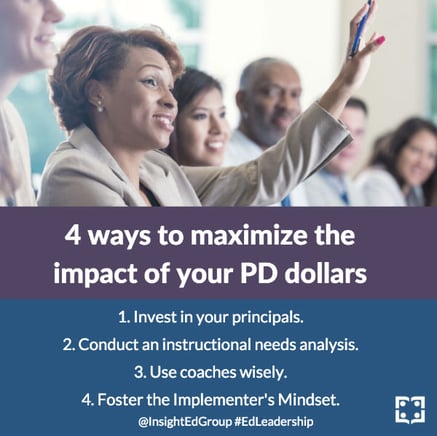 This post is excerpted from the Education Week article entitled, “4 Ways to Maximize the ROI on Professional Development Spending,” by Jason Culbertson, President of Insight Education Group.
This post is excerpted from the Education Week article entitled, “4 Ways to Maximize the ROI on Professional Development Spending,” by Jason Culbertson, President of Insight Education Group.
Are you getting the most from your professional development dollars in terms of educator growth and student achievement?
According to TNTP’s The Mirage Report, districts can spend upwards of $18,000 annually per teacher on PD, but what return on investment (ROI) are they getting for that?
My question is not about ROI in financial terms, but how PD can help districts achieve their goals for teaching and learning.
Below are four ways we've seen districts maximize the impact of PD dollars.
1. Invest in your principals.
While only an estimated four percent of federal funds allocated for improving educator performance are spent on principal development, the research is clear that principals have an enormous impact on teacher retention and student achievement.
Last year, we partnered with district executives and principals in the Syracuse City School District to look at what tasks principals were performing and then grouped those tasks in order of importance. We called tasks related to student and educator performance “A-Level” work and built PD offerings around them. We used coaches to help principals do their A-level work and revamped monthly Leadership Academy sessions to focus only on A-level work. The result? Higher performance with minimal cost increases.
2. Conduct an instructional needs analysis.
An instructional needs analysis helps determine what assets educators have and what they will need to develop in order to realize strong results in addressing the district’s instructional priorities.
To conduct the analysis, appoint an owner of the process and use achievement data, educator evaluations, focus groups, and external research to determine what knowledge, skills, attitudes, and habits need to be cultivated in order to realize leaders’ goals for students.
3. Use coaches wisely.
Coaches need deep content knowledge, effective pedagogical skills, and the framework to ensure that the majority of their work happens alongside classroom teachers. To maximize their effectiveness, coaches need support, too.
My colleagues and I have been working with a large state agency that launched a network of literacy coaches throughout the state. Our coaches support these literacy coaches to make sure they are structuring time with teachers well, giving actionable feedback, and fostering a culture of follow-through.
4. Foster the Implementer’s Mindset.
PD should cultivate an “Implementer’s Mindset,” a term my colleagues and I use to describe a leader or teacher’s uncanny ability to maintain discipline, focus, and accountability every day. In helping to turn around struggling schools, we support leaders and teachers in staying the course (discipline), keeping sharp alignment (focus), and investing in each other’s success (accountability).
In practice this means taking stuff off the plate, not allowing anything to get put back on it, and believing success happens when your colleagues are successful also.
